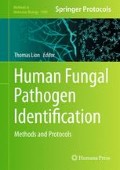Abstract
The detection of fungal elements and their characterization in patient specimens provides fundamental information. Culture-based methods, though often slow, may yield the specific etiological agent, and may allow susceptibility testing to be performed. Proper collection and transportation of the specimen is essential. Particularly, sterile materials are important for diagnosis of invasive fungal infections.
Therefore, culture and direct microscopy should be performed on all suitable clinical specimens when fungal disease is suspected. Numerous different media for culturing and identifying fungi are available, and those important for diagnosing mycoses as well as the most important staining methods for direct microcopy are described.
Access this chapter
Tax calculation will be finalised at checkout
Purchases are for personal use only
References
Verweij PE, Meis JF (2000) Microbiological diagnosis of invasive fungal infections in transplant recipients. Transpl Infect Dis 2:80–87
Arendrup MC, Bille J, Dannaoui E, Ruhnke M, Heussel CP, Kibbler C (2012) ECIL-3 classical diagnostic procedures for the diagnosis of invasive fungal diseases in patients with leukaemia. Bone Marrow Transplant 47:1030–1045
Alexander B, Pfaller M (2006) Contemporary tools for the diagnosis and management of invasive mycoses. Clin Infect Dis 43:S15–S27
Chandrasekar P (2009) Diagnostic challenges and recent advances in the early management of invasive fungal infections. Eur J Haematol 84:281–290
Willinger B, Kurzai, Kienzl O (2014) Diagnostics of fungal infections. In: Kurzai O (ed) Human fungal pathogens. The mycota XII, 2nd edn. Springer, Heidelberg, Berlin, pp 244–247
Vyzantiadil TA, Johnson EM, Kibbler CC (2012) From the patient to the clinical mycology laboratory: how can we optimise microscopy and culture methods for mould identification? J Clin Pathol 65:475–483
Larone DH (2011) Medically important fungi. A guide to identification. ASM Press, Washington DC, USA
Clinical and Laboratory Standards Institute (2012) Principles and procedures for detection of fungi in clinical specimens—direct examination and culture; approved guideline, CLSI document M54-A. Clinical and Laboratory Standards Institute, Villanova, PA
Scognamiglio T, Zinchuk R, Gumpeni P, Larone DH (2010) Comparison of inhibitory mould agar to Sabouraud dextrose agar as a primary medium or isolation of fungi. J Clin Microbiol 48:1924–1925
www.mycology.adelaide.edu.au/Laboratory_Methods/Culture_Techniques_and_Media/pda.html
Rinaldi MG (1982) The use of patato flake agar in clinical mycology. J Clin Microbiol 15:1159–1160
Chiarini A, Palmeri A, Amato T, Immordino R, Distefano S, Giammanco A (2008) Detection of bacterial and yeast species with the Bactec 9120 automated system with routine use of aerobic, anaerobic, and fungal media. J Clin Microbiol 46:4029–4033
Meyer MH, Letscher-Bru V, Jaulhac B, Waller J, Candolfi E (2004) Comparison of mycosis IC/F and plus aerobic/F media for diagnosis of fungemia by the bactec 9240 system. J Clin Microbiol 42:773–777
Procop GW, Cockerill FR 3rd, Vetter EA, Harmsen WS, Hughes JG, Roberts GD (2000) Performance of five agar media for recovery of fungi from isolator blood cultures. J Clin Microbiol 38:3827–3829
www.eucast.org : EUCAST DEFINITIVE DOCUMENT E.DEF 7.3. Method for the determination of broth dilution minimum Inhibitory concentrations of antifungal agents for yeasts.
Arendrup MC, Guinea J, Cuenca-Estrella M, Meletiadis J, Mouton JW, Lagrou K, Howard SJ, The Subcommittee on Antifungal Susceptibility Testing (AFST) of the ESCMID European Committee for Antimicrobial Susceptibility Testing (EUCAST) (2008) EUCAST definitive document EDef 7.1: method for the determination of broth dilution MICs of antifungal agents for fermentative yeasts. Clin Microbiol Infect 14:398–405
Clinical and Laboratory Standards Institute (2004) Method for antifungal disk diffusion susceptibility testing of yeasts: approved guideline. CLSI Document M44-A2. Clinical and Laboratory Standards Institute, Wayne, PA
Clinical and Laboratory Standards Institute (2009) Zone diameter interpretative standards, corresponding minimal inhibitory concentration (MIC) interpretative breakpoints, and quality control limits for anti-fungal disk diffusion susceptibility testing of yeasts; informational supplement, 3rd edn., CLSI document M44-S3. Clinical and Laboratory Standards Institute, Villanova, PA
Clinical and Laboratory Standards Institute (2010) Reference method for antifungal disk diffusion testing of non-dermatophyte filamentous fungi; approved guideline. CLSI document M51-A. Clinical and Laboratory Standards Institute, Villanova, PA
Clinical and Laboratory Standards Institute (2010) Performance standards for antifungal disk diffusion testing of non-dermatophyte filamentous fungi: informational supplement. CLSI document M51-S1. Clinical and Laboratory Standards Institute, Villanova, PA
Kauffman CA, Fisherack JF, Sobel D, Newman CA (2011) Candida urinary tract infections—diagnosis. Clin Infect Dis 52(S6):S452–S456
Author information
Authors and Affiliations
Corresponding author
Editor information
Editors and Affiliations
Rights and permissions
Copyright information
© 2017 Springer Science+Business Media New York
About this protocol
Cite this protocol
Willinger, B. (2017). Culture-Based Techniques. In: Lion, T. (eds) Human Fungal Pathogen Identification. Methods in Molecular Biology, vol 1508. Humana Press, New York, NY. https://doi.org/10.1007/978-1-4939-6515-1_10
Download citation
DOI: https://doi.org/10.1007/978-1-4939-6515-1_10
Published:
Publisher Name: Humana Press, New York, NY
Print ISBN: 978-1-4939-6513-7
Online ISBN: 978-1-4939-6515-1
eBook Packages: Springer Protocols

